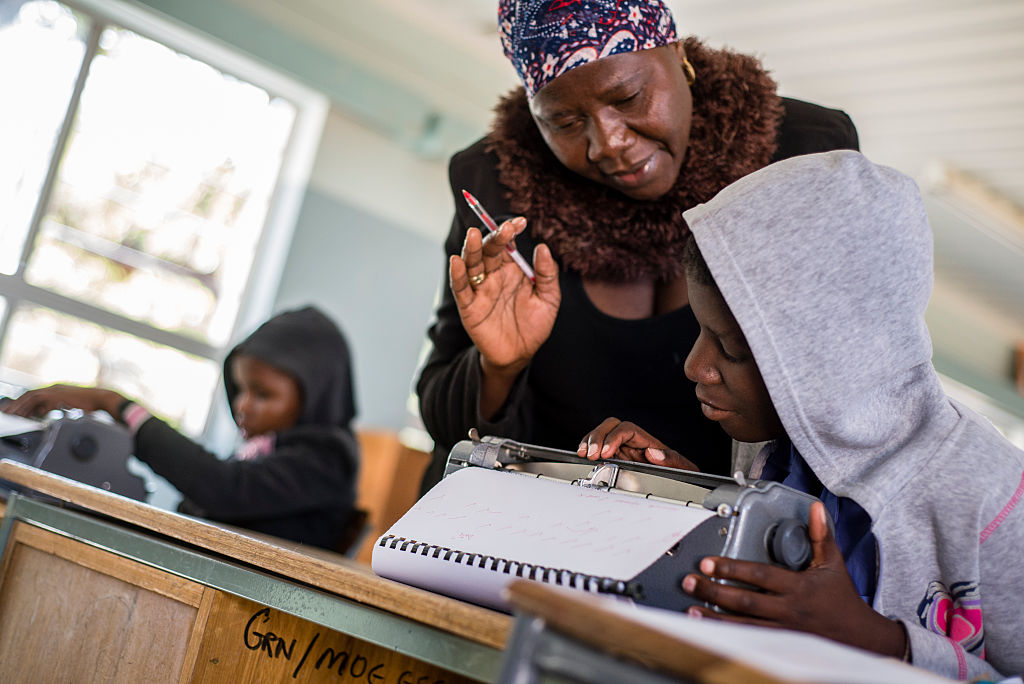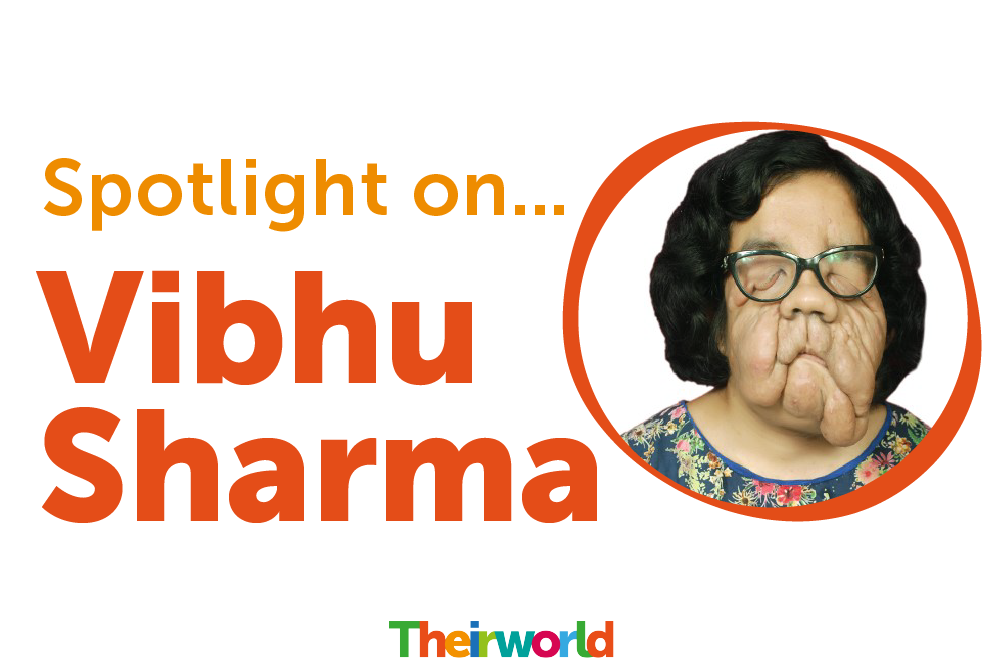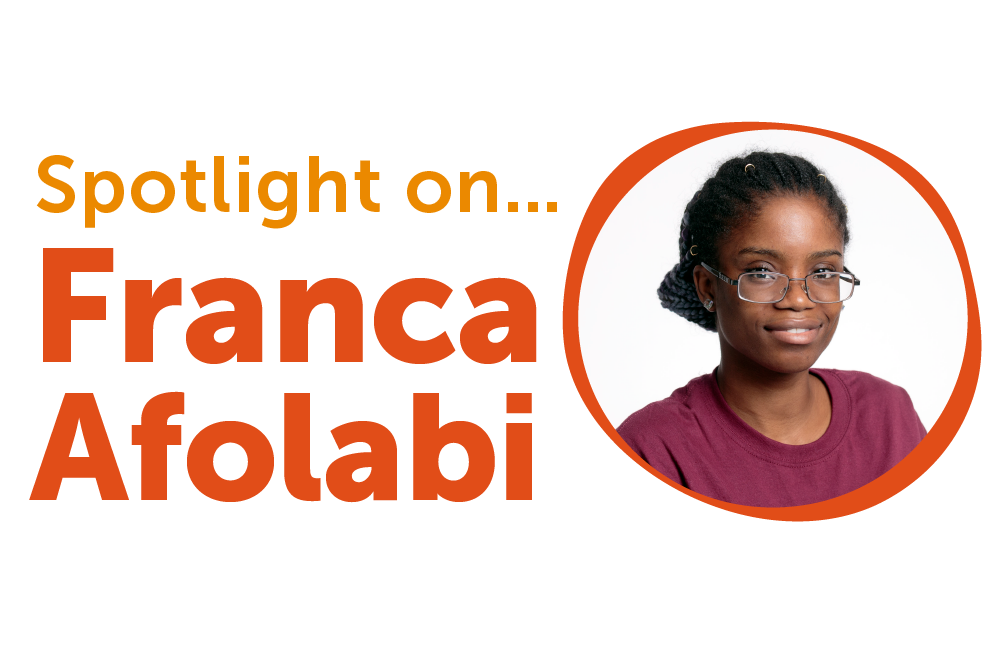
Children with disabilities must have the same educational opportunities as others

Children with disabilities, Spotlight On ...
During Disability History Month in the UK, we talk to Theirworld’s Disability and Inclusion Research Consultant Vibhu Sharma about the importance of inclusive education.
Vibhu Sharma was born and brought up in Delhi, India. After earning a Bachelor’s degree in English Literature, she moved to Scotland, where she achieved a Master’s degree in Inclusive Education from the University of Edinburgh.
Vibhu now works with Theirworld as a Disability and Inclusion Research Consultant. She leads a project on assistive technologies and guides the organisation’s initiatives on making them disability-inclusive.
In the latest in our Spotlight On … series, which features inspiring people from the world of education, Vibhu talks about the importance of inclusive education and the support that students with disabilities need to be successful in education.
Why is prioritising inclusive education important to you and what specific actions do schools and governments need to take?
Inclusive education is very close to my heart. I feel that every child has a right to inclusive education, be accepted in a school of their choice and be enabled to access the same curricular and co-curricular materials as their non-disabled peers.
Being a person with complete blindness and growing up in India, I had to face the discrimination that is manifested in the mainstream education system. Schools are not willing to accept children with disabilities in mainstream schools. Even if they are admitted, children with disabilities face a number of barriers, such as untrained teachers, inaccessible reading materials, lack of access to assistive technologies. The list is endless.
While I had these struggles, I also had the opportunity to represent the status of inclusive education in India at a number of national and international conferences, along with obtaining a Master’s degree in inclusive education.
As I progressed, I realised that the struggles that I had were not mine – they were the struggles of the 40% to 80% of children with disabilities who continue to be either out of school or face challenges in developed and developing countries.
I realised I had been the privileged one. Although there have been many challenges I have had to face despite my enrolment in a mainstream school, I had been able to overcome them.
Governments and schools need to work in collaboration. There could be many actions that can be taken to provide mainstream education for children with disabilities. For instance, governments could mandate that all teacher preparation programmes need to include at least one module on accommodating students with disabilities in a mainstream classroom.
Similarly, schools can require that teachers have training in accommodating students with disabilities in mainstream classrooms before they hire them. Schools need to ensure that accepting children with disabilities in a mainstream school is not enough – they need to ensure they have sufficient resources, like assistive technologies, accessible curriculum and infrastructure.
They also need enough awareness in the teaching and non-teaching staff on providing equal opportunities to children with disabilities, similar to their non-disabled peers.
What kind of support do students with disabilities need to be successful in their education?
Students with disabilities are, first and foremost, students who happen to have a disability. They must have the same educational opportunities as a non-disabled student. There cannot be a one-size-fits-all model, as disability is diverse and there can be a diversity even within the students with a similar or a different disability.
It is necessary to first assess what kind of support a particular student with any disability requires and respond to their specific needs. For example, a student who has visual impairment might require Braille and/or a screen-reading software with accessible materials to function independently in accessing their academics. Similarly, someone who has a hearing impairment might benefit from captioning or sign language.
To best support students with disabilities in accessing education and enabling them to be successful, schools and teachers need to first assess and understand the needs of the student through collaboration with other stakeholders, through talking to the student, their parents, organisations of persons with disabilities and assistive technology experts – and then develop a needs-based plan for the student.
It is also important to understand that these needs are not static and may change as the student progresses from one academic level to the next. So this process of assessing, evaluating and responding to the needs of a student has to be a continuous process.
What one piece of advice would you give to leaders trying to make their organisations, companies or communities more inclusive of people with disabilities?
People with disabilities are, first and foremost, people. The fact that they have a disability is secondary, as they are an asset to any organisation or community that is sensible enough to understand their specific needs and respond to them.
Business organisations, for example, need to see making their products and services disability-inclusive and see disability inclusion as a source of market opportunity, not as mere compliance. Leaders need to have this on their agenda and understand that disability is a part of diversity, and they cannot claim to be in favour of diversity inclusion if they leave persons with disabilities behind.
It is essential to promote the awareness and understanding around disability inclusion. The best people to help you do this are the people with disabilities themselves, who can share their first–hand experience. It is necessary that before taking any step towards disability inclusion, people with disabilities are consulted.
If organisations are serious about disability inclusion, they need to hire persons with disabilities to work for them and create enabling work environments that facilitate employees with disabilities to perform their job and allow them to grow professionally.
Why is celebrating Disability History Month important?
Because it is the time to recognise the achievements and contributions of persons with disabilities and highlight their value to the rest of the non-disabled world.
The achievements of persons with disabilities tend to get lost either because the non-disabled world views them as objects of sympathy or charity, or they cannot associate disability with something that is huge and different from most other people.
For example, Stephen Hawking was a person with a disability. He had motor neurone disease which gradually paralysed him. But I can bet that many people would not know that, or would not believe it, because they carry a stigma towards disabilities and persons with disabilities and cannot believe that someone with a disability could do what Mr. Hawking did.
So I think it is important to celebrate this month to recognise the small and big contributions that people with disabilities have to offer in their respective domains. At the same time, it is essential to recognise the shortcomings of our society towards accommodating persons with disabilities and try to fix them.
When working with organisations like Theirworld, what is your main goal?
I was hired by Theirworld to work on the project that will help map what assistive technologies are used by students with disabilities and develop policy briefs to ensure that such technologies can be made available to a larger number of children with disabilities, especially in developing countries where they do not have access to them.
Since disability is a cross-cutting issue, I was also hired to help the organisation include the lens of disability inclusion across its other initiatives, such as early childhood education, education of refugee children, the Global Youth Ambassador programme and so on.
My goal is to assist the organisation to have initiatives that are disability-inclusive, that are not just cognisant of children with disabilities but are also prepared and ready to accept and accommodate them in Theirworld’s programmes.
What are you learning through working on the task force report with Theirworld?
I think this is a great initiative. Not only does it focus on the issues in accessing education and employment for persons with disabilities, but it has tangible recommendations that come from best practices that have been implemented to solve some of the biggest challenges that persons with disabilities have in accessing education and employment.
I think the recommendations of the report – from analyses and having seen the best practices in some of the world’s largest businesses – are a good lesson for any organisation big or small, to implement the same strategies, and be disability-inclusive.
What achievements with Theirworld are you most proud of?
I am proud that the organisation has stepped ahead in its approach towards disability and inclusion and sees hiring persons with disabilities on their capability and value.
I am also proud the organisation has become more agile and nimble to the needs of employees with disabilities. For example, it uses more accessible technologies. Our platforms are becoming increasingly accessible and many of our Global Youth Ambassadors (GYAs) are now young people with disabilities.
We have our two forthcoming reports – one on assistive technologies and he task force report, on education, employment and training for persons with disabilities – to be proud of as well.
More news

